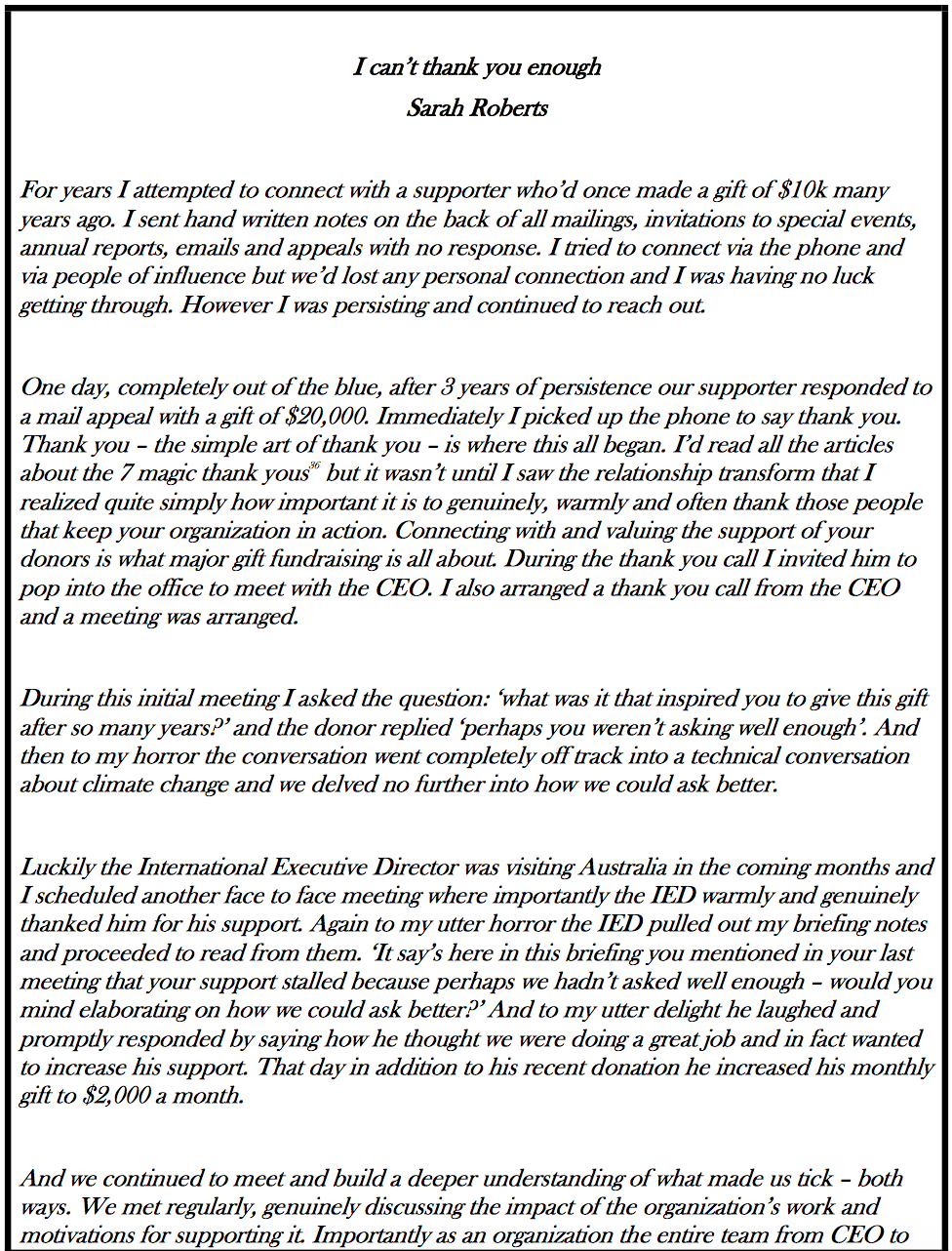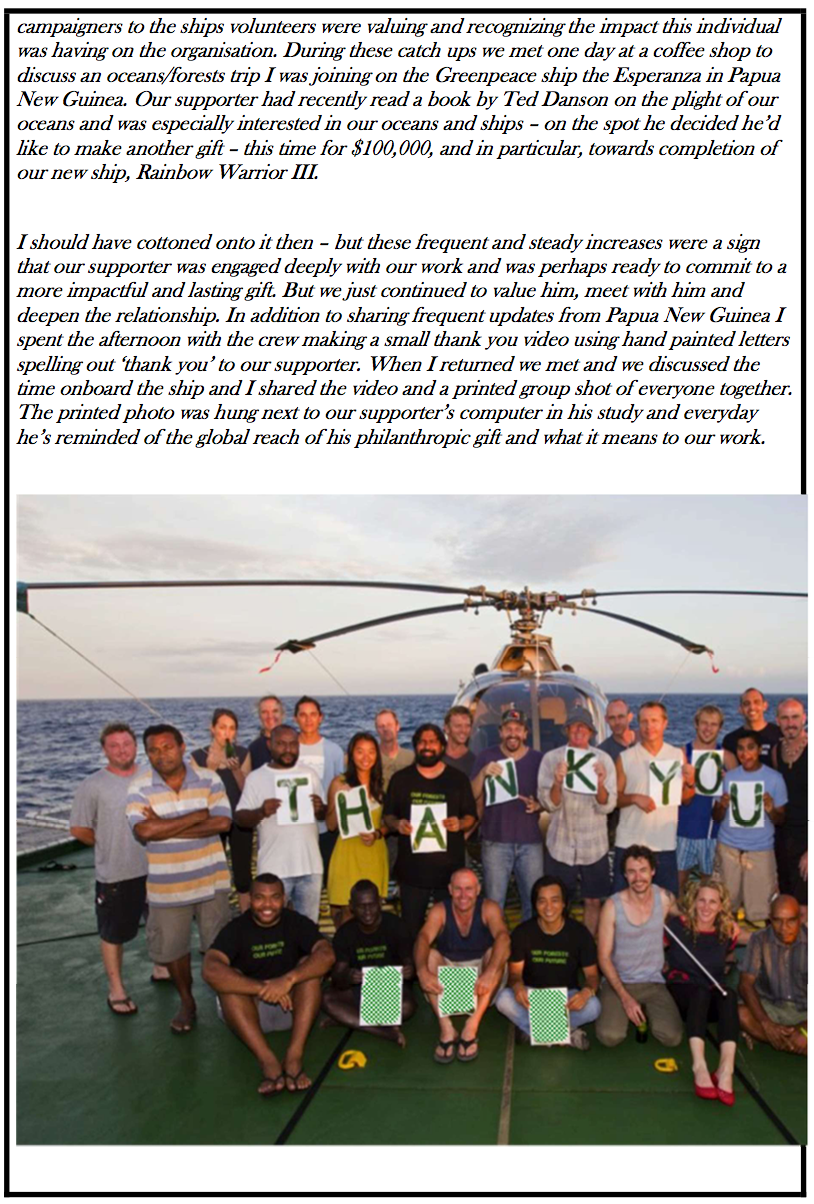CDE project 9: putting the principles and actions into practice — part 4
- Written by
- The Commission on the Donor Experience
- Added
- April 25, 2017
Seeing the relationship from the donor’s point of view
Most major donor fundraisers use a ‘step’ process or moves management system to move from prospect identification to securing a gift and then to stewardship. There are many examples [31]—and many organisations have their own individually tailored version.
The common feature of these processes and models is that they focus on a number of actions over time, moving towards an objective of securing a major gift.
There is an alternative and more donor-focused way of looking at things. Rather than think about the next move towards a gift, think about how to match the donor’s needs, interests and passions to the issues your organisation works on.
The end result may well be the same—a large financial contribution to the organisation’s work—but the experience for the donor is likely to be very different. If major gift fundraisers genuinely make the next move according to what the donor might want and enjoy, the gift will result. The most successful major donor fundraisers essentially reframe their relationships with donors from being fundraisers to being advisors by adopting this approach.
Seeing the relationship from the point of view of the donor requires a complete mindshift so that every stage of the process is focused on the donor. That means that it is not enough to simply invite everyone to the next event in the charity’s calendar. Rather, you need to devise the right next interaction to deepen the donor’s relationship (which of course might happen at the next event).
To do this, you will have to listen very hard to what the donor is indicating or suggesting. Often donors and prospects are too polite to be too blunt about what they really think or want, but major donor fundraisers who have exceptional listening skills can pick up on the clues, hints or even requests that lead to the right next step.
The table below summarises the key steps and suggests how the key donor facing steps might be translated into a more donor-focused approach:


* Note in steps 1 (identify) and 2 (research and qualify) major donor fundraisers need to adhere to regulation and best practice around donor and prospect contact permissions and preferences. In this area, major donors are no different from other donor groups.
Being donor centric should perhaps be an obvious point at the thanking and stewardship steps, but these are both points where fundraisers and organisations come in for criticism, despite many organisations having formal policies:
‘Sometimes once the cheque is written, the donor is never contacted again, or aren’t made to feel appreciated.’
‘fundraisers often don’t contact them after they’ve made a gift and even offer “glib answers” to questions about where their money is going and how it will be used.’
Angela Kail, co-author Giving More and Better, New Philanthropy Capital [32]
‘It’s really important to me that organisations report on what they have done. I always notice who signs letters. Our ad-hoc giving is done on the basis of how much feedback we get from each of the charities we donate to from the previous year.’
Sir Stelios Haji-Ioannou, founder easyJet [33]
Angela Kail suggests there is ‘a general lack of skills and knowledge in the fundraising sector when it comes to building relationships with major donors; as well as a general culture of short-termist thinking in the sector.’ [34]
Yet we know that effective thanking has the potential to transform relationships. Below is a contribution from Sarah Roberts from her time as Major Donor Fundraiser for Greenpeace Asia Pacific. It is reproduced here in its entirety but was first published as a blog by Reinier Spruit on 101 fundraising. [35]


One last point on thanking. There are numerous ways [37] to make thank you letters effective. A personally important one for me is not asking again in the thank you letter. I recently experienced this in the context of an emergency appeal. The natural disaster happened and I gave on day one as the scale of destruction became apparent through news coverage and on Twitter. The next day I received an email thank you and an ask to give again. I know this works—but as a donor, I was left feeling inadequate, as if the organisation thought I had not done enough. I think a thank you and another ask a few days later, perhaps with specific information about how my first gift was helping and the challenge was growing, might have resulted in both a better donor experience and more money to the organisation.
So the key message is simple but sometimes hard to do: at all steps along the way see the relationship from the donor’s point of view.
----------------------
[31] See here for an explanation of one example of a step solicitation process http://www.managementcentre.co...
[32] http://www.civilsociety.co.uk/...
[33] Read more at http://philanthropy.coutts.com...
[34] http://www.civilsociety.co.uk/...
[35] http://101fundraising.org/2016...


















